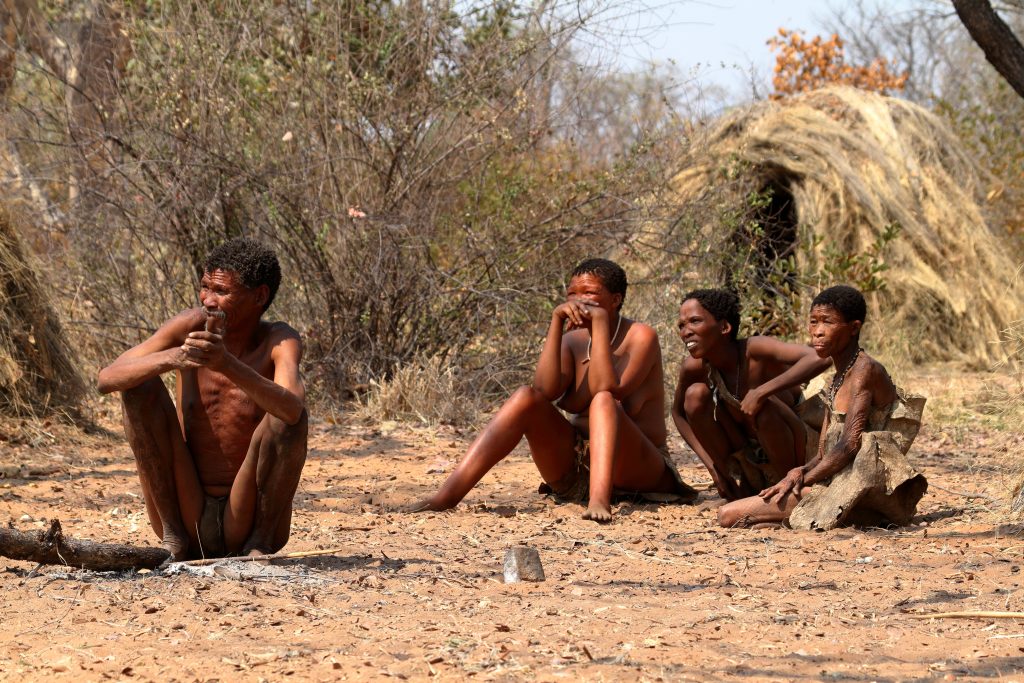
The San people of Namibia are considered among the earliest inhabitants of southern Africa, with archaeological evidence tracing their ancestry back over 20,000 years. Often referred to as “Bushmen” (a term now considered outdated or derogatory in some contexts), the San represent a rich and complex culture that has endured extreme environmental, political, and economic changes across centuries.
Today, the San face significant challenges—but their history, cultural practices, and environmental knowledge continue to play an important role in the understanding of human history and sustainable living.

Origins and Population of the San People
The San are part of the broader Khoisan language group, which includes the Khoikhoi (traditionally pastoralists) and the San (traditionally hunter-gatherers). In Namibia, San communities are primarily found in the northeastern regions, especially around Bushmanland, Otjozondjupa, and the Kalahari border regions near Tsumkwe, as well as scattered areas across the Nyae Nyae Conservancy.
There are approximately 30,000 San people living in Namibia, though exact numbers vary due to limited census data and differing classifications. The main San groups in Namibia include the Ju/’hoansi, !Kung, Hai//om, and Khwe, each with its own dialect, social customs, and adaptations to environment.
Traditional Way of Life
Historically, the San lived in small, mobile bands that relied on hunting wild game and gathering plant foods, such as roots, berries, nuts, and tubers. They developed exceptional tracking abilities and a deep understanding of animal behavior, water sources, and seasonal changes—skills that were essential for survival in arid regions like the Kalahari Desert.
Traditional San life was organized communally. Decisions were made collectively, and resources were shared among group members. Unlike many hierarchical societies, San communities operated with relatively egalitarian structures, with leadership based more on experience and consensus than formal authority.
Although modern pressures have reduced the practice of nomadic hunting and gathering, many San individuals still retain and teach tracking, craft-making, and plant-use knowledge, some of which is now integrated into eco-tourism and bushcraft education initiatives.
Language and Cultural Identity of the San People
San languages belong to the Khoisan language family, known for their unique click consonants. In Namibia, the most widely spoken San languages include Ju|’hoansi, !Xung, and Khwedam. These languages are endangered due to pressures from dominant languages such as Afrikaans, English, and Bantu tongues like Oshiwambo.
Language plays a key role in cultural identity. Oral storytelling, traditional knowledge, and rituals are passed down verbally. As San children are increasingly educated in non-native languages, many community leaders and NGOs are working to document and preserve indigenous vocabulary, grammar, and oral histories.
Efforts are also being made to create mother-tongue educational materials and to recognize San languages in official contexts, though these efforts are underfunded and face bureaucratic barriers.
Challenges in the Modern Era
The San have experienced significant displacement since the colonial and post-independence periods. Much of their ancestral land has been turned into farms, private reserves, or conservation areas, leaving communities landless or relocated to marginal zones with poor access to resources.
Key challenges facing San communities in Namibia today include:
- Lack of land rights and formal recognition of customary territories
- Poverty, food insecurity, and unemployment
- Limited access to education and healthcare
- Discrimination and marginalization within broader Namibian society
Many San people have been pressured into sedentary lifestyles without adequate support systems, leading to a loss of traditional knowledge and dependency on external aid. Alcoholism and lack of economic opportunity are ongoing concerns, especially among the younger generation.
Several organizations—such as the Nyae Nyae Development Foundation and Working Group of Indigenous Minorities in Southern Africa (WIMSA)—are advocating for the cultural and land rights of the San, often in collaboration with local leaders.
Conservation and Cultural Tourism
In recent years, community-based tourism has emerged as a pathway to both economic development and cultural preservation. Initiatives like the Nhoma Safari Camp and the Nyae Nyae Conservancy provide employment and income while allowing San communities to share their heritage on their own terms.
At these camps, guests can learn about traditional tracking, plant uses, fire-making, and cultural dances—led by San community members themselves. Unlike staged cultural villages, these experiences are embedded in real community partnerships, with a portion of proceeds going directly back to the local population.
Such initiatives are not without complexity—questions remain about long-term sustainability, cultural sensitivity, and how to protect sacred knowledge. However, many community members report a renewed sense of pride in sharing their culture with interested visitors, provided it’s done respectfully.
Why the San Matter
The San people of Namibia are important not just for their heritage, but for the lessons they offer in resilience, adaptation, and ecological knowledge. Their history illustrates how societies can live with limited impact on the land, and how oral traditions can preserve critical survival information across generations.
At the same time, their current reality highlights broader issues facing indigenous populations globally: land loss, cultural erosion, and lack of political power.
Supporting San communities—through ethical tourism, land rights advocacy, and cultural preservation efforts—is one way travelers and conservationists alike can contribute to a more just and inclusive future in Namibia.
Join us Walking Wild in Namibia to learn more about the San people
Learn More or Support
Here are some recommended organizations and initiatives:
- Nhoma Safari Camp: www.nhoma-camp.com
- Nyae Nyae Development Foundation: www.nndf.org.na
- WIMSA (Working Group of Indigenous Minorities in Southern Africa): www.wimsa.org.na
- !Khwa ttu San Heritage Centre (South Africa): www.khwattu.org


